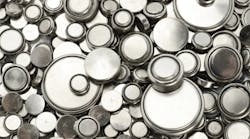Virtually all battery-based power-management designs depend on the associated battery, so design starts by picking the specific battery type. The battery may be the non-rechargeable primary type or the rechargeable secondary type. The most widely used rechargeable battery-based systems may employ nickel-cadmium (NiCd), nickel-metal-hydride (NiMH), lithium-ion (Li-ion), or Li-ion polymer, though silver-zinc batteries are now emerging.
NiCd batteries were the first widely used battery for portable equipment. But with the introduction of batteries featuring higher energy densities and less toxic metals, designers are turning from NiCd and investigating these newer technologies.
A disadvantage with NiCd is its memory effect, which requires periodic discharge to prevent charging problems. Advantages include its simple charge characteristics and its ability to accept a high number of charge/discharge cycles.
The first successor to NiCd was the NiMH battery, which provides high energy density and the use of environmentally friendly metals. NiMH offers about 30% to 40% higher energy density than NiCd. Also, NiMH batteries are less prone to memory effects. When charging, NiMH batteries employ a more complex charge algorithm and generate some heat, and they require a longer charge time than the NiCd.
Now, lithium batteries have taken center stage. The lightest of all metals, lithium offers the greatest electrochemical potential and provides the largest energy density per weight. Rechargeable batteries using lithium metal anodes (negative electrodes) can provide both high voltage and excellent capacity. However, safety problems loom with this type of lithium battery.
Although slightly lower in energy density than lithium metal, Li-ion is safe, provided certain precautions are met when charging and discharging. Li-ion energy density is about twice that of the standard NiCd battery.
Besides high capacity, the load characteristics are reasonably good and behave similarly to NiCd in terms of discharge characteristics. Their relatively high cell voltage enables Li-ion battery packs consisting of only one cell. Li-ion’s life expectancy is 300 charge/discharge cycles, with 50% capacity at 500 cycles.
An added requirement for Li-ion batteries is a protection circuit that limits each cell’s peak voltage during charge and prevents its voltage from dropping too low on discharge. The protection circuit limits the maximum charge and discharge current and monitors the cell temperature.
Exercise caution when handling and testing Li-ion batteries. Do not short circuit, overcharge, crush, drop, mutilate, penetrate, apply reverse polarity, expose to high temperature, or disassemble. Only use the Li-ion battery with the designated protection circuit.
The Li-ion polymer battery differs from the strict Li-ion type in terms of fabrication, ruggedness, safety, and thin-profile geometry. Unlike Li-ion, there’s no danger of flammability because it doesn’t use a liquid or gelled electrolyte. However, Li-ion polymer is still a work in progress, with operational improvements expected. Compared to conventional Li-ion, Li-ion polymer offers simpler packaging and a lower profile because its electrodes can be easily stacked.
NiCd and NiMH cells provide 1.25 V (nominal), while Li-ion cells deliver 3.6 to 4.2 V. Series-connected battery packs with fewer cells usually perform better than those with 12 cells or more. Parallel connections provide higher ampere-hour (Ah) ratings. Often, a parallel connection is the only option to increase the battery rating. Among the different battery chemistries, Li-ion lends itself best to parallel connection.
All batteries exhibit self-discharge, which is most noticeable with nickel-based varieties. Generally, nickel-based batteries discharge 10% to 15% of their capacity in the first 24 hours after charge, after which it’s another 10% to 15% per month. Self-discharge of the Li-ion battery is less than the nickel-based systems. The Li-ion self-discharge is about 5% in the first 24 hours and 1% to 2% thereafter. The addition of a protection circuit increases the self-discharge to 10% per month.
New Power Sources
Although it is relatively new and not yet in widespread use, the ZPower silver-zinc rechargeable battery appears to offer performance that competes with Li-ion and Li-polymer. It has an extremely high ratio of energy to volume (Wh/l) in applications such as notebook computers, cell phones, and consumer electronics. In fact, ZPower is the only rechargeable battery that beats Li-ion on energy density for consumer applications.
ZPower batteries have an intrinsically safe water-based chemistry that contains no lithium or flammable solvents. Unlike Li-ion and Li-polymer batteries, these batteries are free from the problems of thermal runaway, fire, and danger of explosion. They’re also free from the regulations that limit the size of lithium-containing batteries on airplanes.
Besides offering high-performance and safety, ZPower batteries use an environmentally friendly chemistry that allows recycling of battery cells and reuse of contents. Unlike other traditional batteries, ZPower batteries have no heavy metals and no toxic chemicals.
Micro fuel cells are another candidate for portable, battery-based systems. UltraCell Corp. announced the availability of the XX55 reformed methanol fuel cell, the industry’s first and only ultra-compact, rugged portable fuel cell equipped with a hybrid battery system.
The XX55’s technology offers fully optimized battery integration, allowing complete functionality using an industry-first clip-on and clip-off battery module system. The associated rechargeable battery performs two tasks. Initially, it activates the fuel cell and then supplies peak power when required to do so because the fuel cell can’t react to a load spike as quickly as the battery. Then, the fuel cell recharges the battery when its output falls below a certain voltage.
This fuel cell delivers 55 W average and 80 W peak, with a typical capacity of eight hours of continuous operation with the smallest fuel cartridge. Its disposable methanol cartridge can be easily replaced when the fuel is exhausted. Fuel cartridges are also available with up to a 500-hour capacity. The system is the size of a typical hardbound book and four times lighter and six times smaller than the nearest production portable fuel-cell system in its power class.

